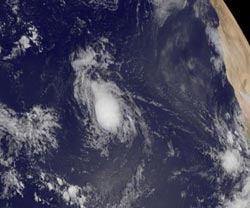NASA sees newborn Tropical Storm Joyce in the Central Atlantic

This visible image of Tropical Storm Joyce was captured by NOAA's GOES-13 satellite on Aug. 23 at 7:45 a.m. EDT. Credit: NASA GOES Project<br>
When NOAA's GOES-13 satellite captured an image of Tropical Depression 10 (TD10) on Aug. 23 at 7:45 a.m. EDT it appeared to have a well-rounded circulation. Infrared imagery indicated cold cloud top temperatures. Cold cloud top temperatures as cold as -63 Fahrenheit (-52 Celsius) show strength in the uplift of air that helps create strong thunderstorms that make up the tropical cyclone. The GOES-13 image was created using the NOAA satellite data at NASA's GOES Project, located at NASA's Goddard Space Flight Center in Greenbelt, Md.
On Aug. 23 at 11 a.m. EDT, Tropical Storm Joyce had maximum sustained winds near 40 mph (65 kmh). Joyce was located far from land, about 1,305 miles (2,105 km) east of the Leeward Islands near 15.2 North latitude and 42.2 West longitude. It was moving to the west-northwest near 17 mph (28 kmh).
Satellite data indicates that Joyce is dealing with a dry Saharan air layer, something that usually saps a tropical cyclone's warm, moist air. That dry air is wrapping around the southwestern part of Joyce's circulation.
The Saharan Air Layer is one thing that NASA is going to investigate in its upcoming Hurricane Severe Storm Sentinels (HS3) mission in September, using unmanned aircraft. For more information, go to: http://www.nasa.gov/HS3.
The National Hurricane Center noted that Joyce is following the southern edge of a subtropical ridge (elongated area) of high pressure over the Central Atlantic Ocean. Think of a marble rolling around the edge of a round clock. Once Joyce (the marble in this example) reaches the western edge, it will begin to turn to the northwest and then to the north.
Media Contact
More Information:
http://www.nasa.govAll latest news from the category: Earth Sciences
Earth Sciences (also referred to as Geosciences), which deals with basic issues surrounding our planet, plays a vital role in the area of energy and raw materials supply.
Earth Sciences comprises subjects such as geology, geography, geological informatics, paleontology, mineralogy, petrography, crystallography, geophysics, geodesy, glaciology, cartography, photogrammetry, meteorology and seismology, early-warning systems, earthquake research and polar research.
Newest articles

Properties of new materials for microchips
… can now be measured well. Reseachers of Delft University of Technology demonstrated measuring performance properties of ultrathin silicon membranes. Making ever smaller and more powerful chips requires new ultrathin…

Floating solar’s potential
… to support sustainable development by addressing climate, water, and energy goals holistically. A new study published this week in Nature Energy raises the potential for floating solar photovoltaics (FPV)…

Skyrmions move at record speeds
… a step towards the computing of the future. An international research team led by scientists from the CNRS1 has discovered that the magnetic nanobubbles2 known as skyrmions can be…




















